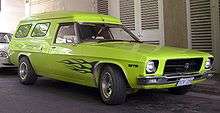Panel van (Australia)

In Australia, panel vans were a development of the Australian "ute" (utility), a variety of pickup based on a car chassis. They were offered by Holden from December 1953 in the FJ model, and by Ford from May 1961, based on the XK Falcon. Panel vans enjoyed tremendous popularity in Australia throughout the 1970s, but by the late 1980s, they began to slowly disappear from Australian roads as demand fell and major manufacturers slowly ceased building them. In British parlance, this body style is referred to as a "car-derived van", and in American as a "sedan delivery".
Most utes usually had an option of metal, then later rigid plastic, shells that would fit over the back of the tray of the ute, thereby extending the vertical space drivers could store in the tray, usually to just above the existing roofline of the passenger cab. Later shells offered plastic windows for ventilation along the sides and even pop-out or swing-out windows at the rear to aid the driver's rear vision. These were eventually integrated into the body of the ute itself to form a hybrid vehicle that, while based on a ute body, offered more rear space than a conventional station wagon with its rear seats folded down. These became known to the Australian public essentially as panel vans.

Initial models were fitted at the rear with swing-down and -up doors (like utes), but later models came equipped with "barn-door" configurations that opened out to the sides of the vehicle, rather than down, aiding the loading of bulky freight into the vehicle without (as badly) damaging the body. Passengers could climb from the interior passenger cab into the cargo bay behind them easily. Later the installation of safety cages which segregated passengers from the cargo area became popular to prevent freight from the back sliding into the passenger cab (and potentially injuring the driver).
The first panel vans were manufactured by Holden and Ford in the late 1950s, but did not become popular until the mid-1960s. By the early 1970s, usually when based on the Holden Kingswood and Ford Falcon model of the time, panel vans had become Australian cultural icons. The Holden Sandman is probably the best-remembered of these: for example, one of the vehicles driven by Mel Gibson in the 1979 movie Mad Max was thought to be either a Holden Sandman or a customised Holden panel van (apparently a 1975 HJ model in both cases). Ford panel vans (known briefly as Sundowners) were also popular, to a lesser degree. Chrysler also came to the party in 1976, offering a CL model Valiant panel van dubbed the Chrysler Drifter, but these could not compete with the popularity of Ford and particularly Holden, and were axed in 1978.

Younger drivers were especially attracted to panel vans, for reasons such as the ease with which a mattress could be installed within the cargo bay. Consequently, panel vans also attracted nicknames such as "sin bins," "shaggin' wagons," "mobile virgin conversion units", "screw canoes," "Scooby-Doo mobiles" (after the Mystery Machine of the Hanna-Barbera animated cartoons), and "fuck trucks". This kind of activity was frequently carried out at the local drive-in theatre. During the 1970s it also became fashionable to decorate the exterior sides with murals, often painted with intricate detail. Along with the Volkswagen Kombi, panel vans were very popular with surfers (or wanna-be's), as it was convenient to sleep in the cargo bay during surfing "safaris", as well as carry boards and other equipment.
Australian police forces also purchased fleets of panel vans to use in a black maria, or paddywagon, role. These were known formally as Divisional Vans and in slang as Divvy Vans.

Painters, electricians, and general labourers also found panel vans ideal for their trades, as the cargo bay offering extended capacity otherwise wasted in passenger space, and a highly customisable interior, without the bulk or extended dimensions of other longer-base vans.
The final production of Holden's Sandman in the HZ series, featured a choice of V8 engines only, along with a four-headlight grille and under bumper front spoiler. According to a GMH Price List dated 25 January 1979, a basic HZ Holden panel van was priced at A$6,076, with the Sandman option package an additional A$1,700. The further optional components also included 5.0 litre V8 engine and a limited slip differential. If a buyer selected every Sandman extra, they would get a bonus velvet mattress with Holden logo embroidered. The price would be more than 150% of the cost of the basic HZ model. By the end of 1979, the Sandman had largely lost its place in the contemporary Australian youth culture - order figures were down and many of the vehicles were now being sold with the stripes and tailgate logos deleted. The Sandman ute was phased out of production prior to the van, the last of which was manufactured in October 1979.
The popularity of panel vans waned in the 1980s. Holden's last release was their WB model. Subsequently, Ford became the sole manufacturer of them until 1999 when production of last entry in the history of the Australian panel van, the Ford Falcon XH model, ceased. In 2003, Holden released a new Sandman, based on their Holden VU Ute of the time. This Sandman was a show car and they were never released, and while they were identified (and marketed) as panel vans, they still retained the rear window and firewall of the ute they were originally based on, preventing movement between the cargo bay and the passenger cab, as offered by traditional panel vans.